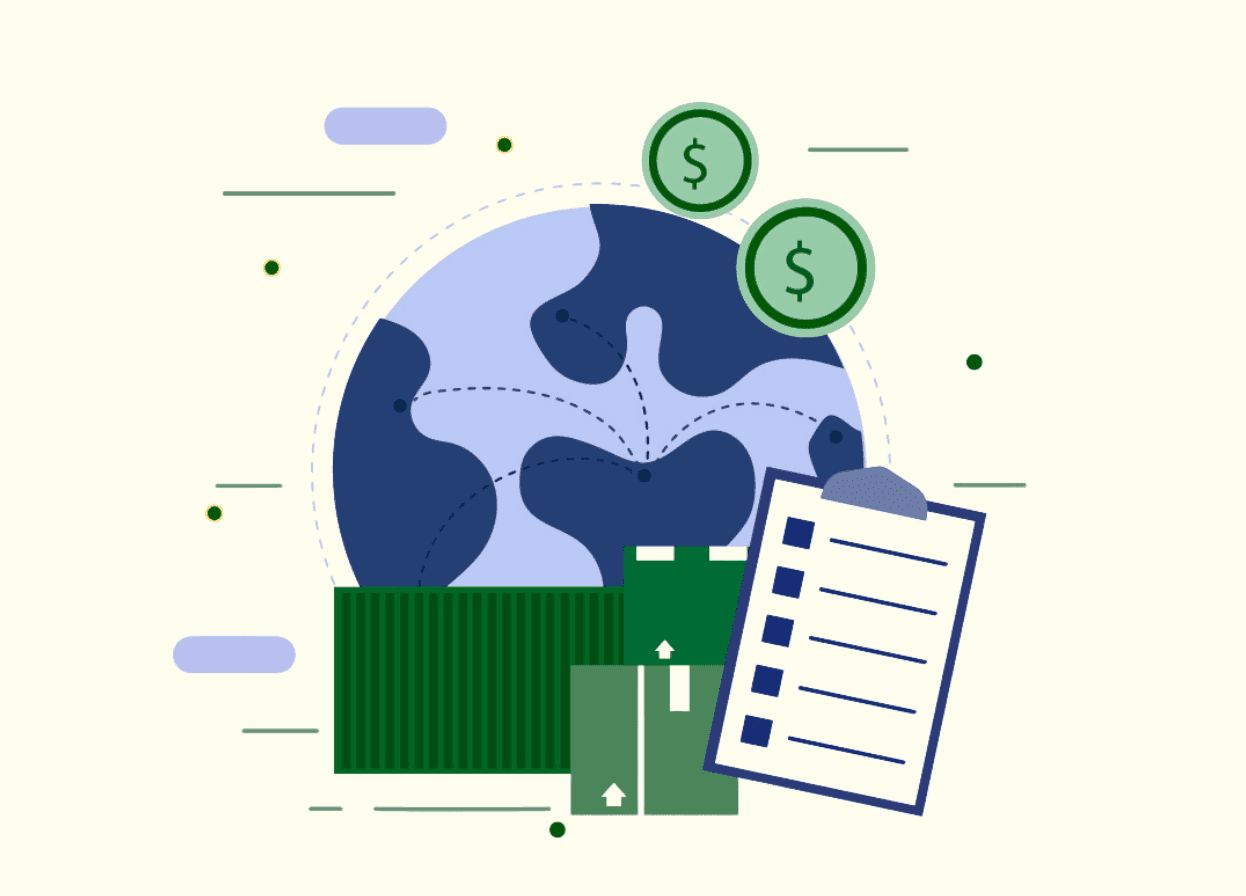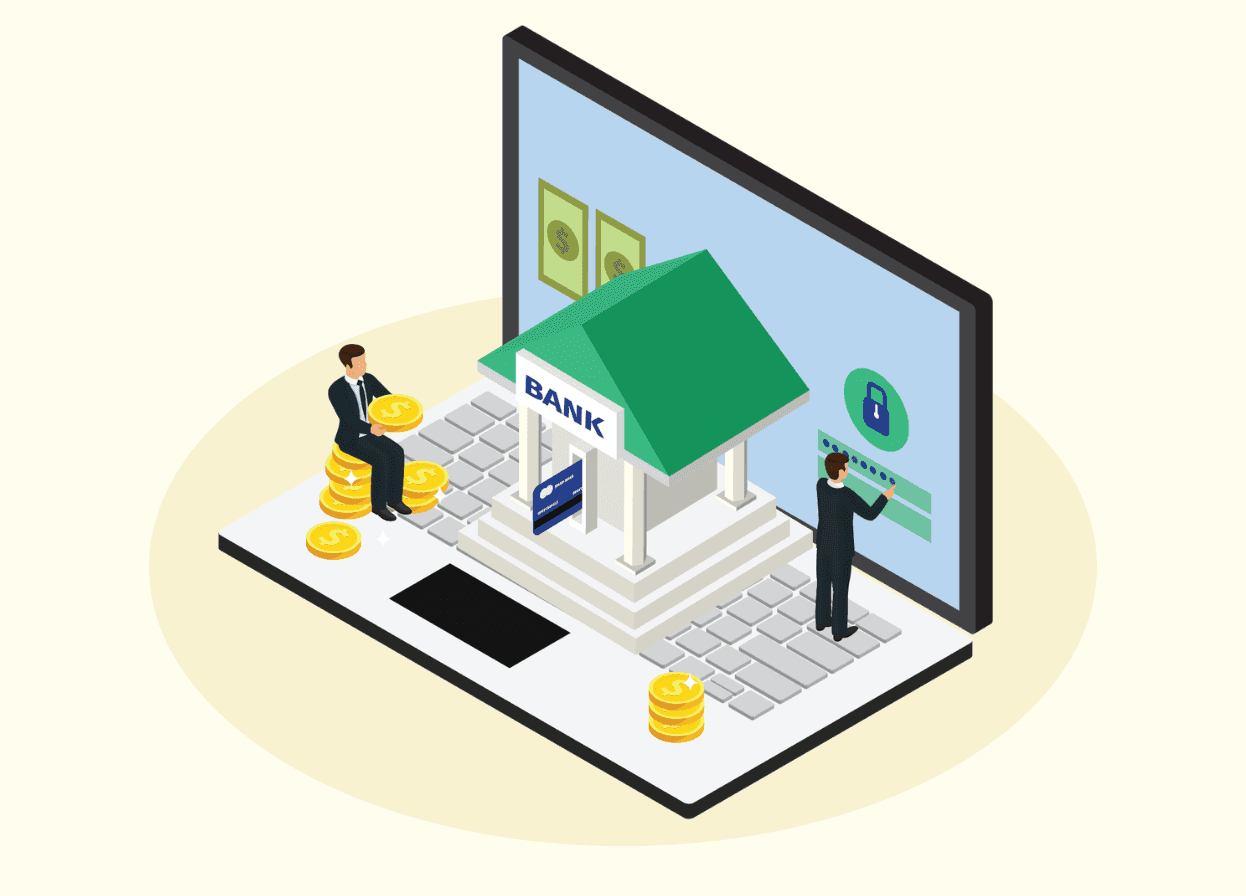What is e-BRC? How can you obtain it, and why do you need it?

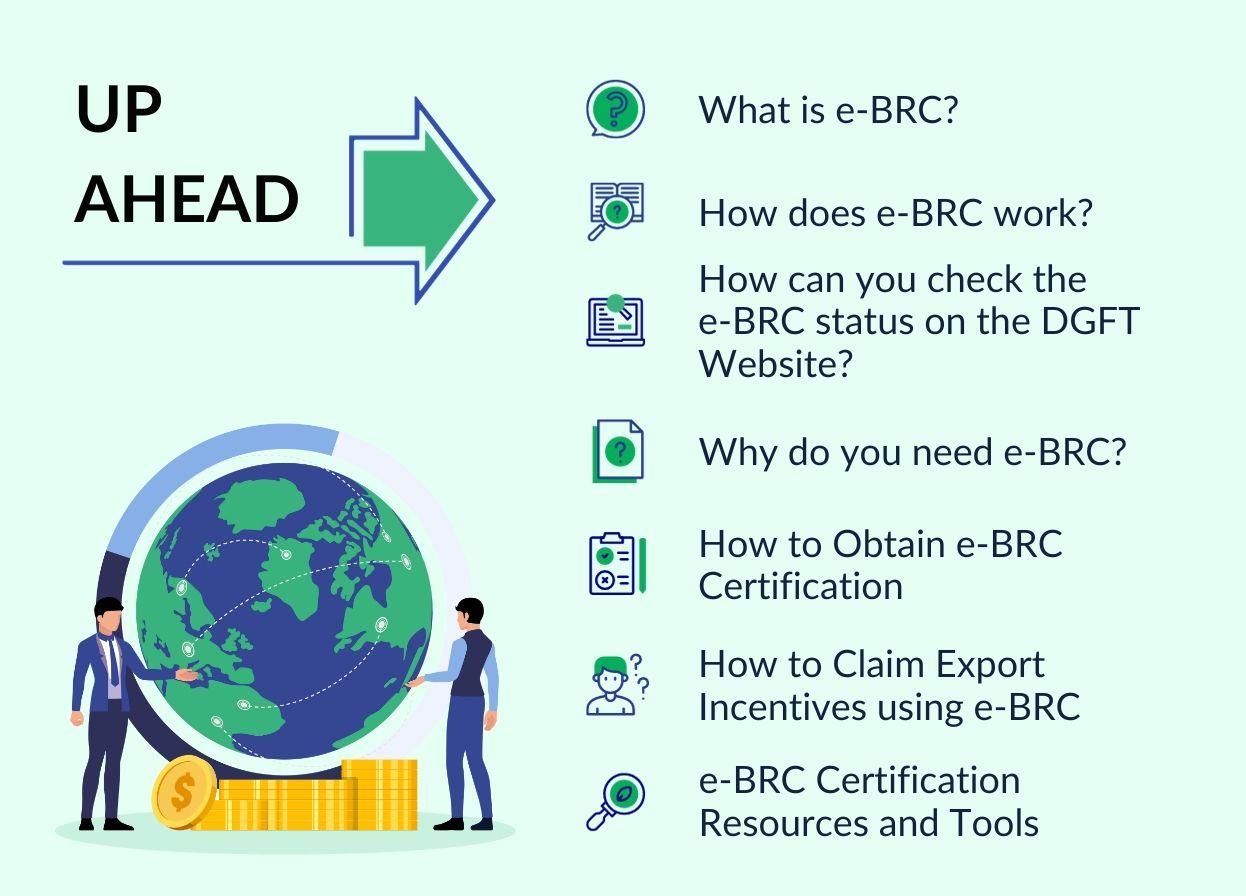

Running a business in India can be profitable. If you take it a step further and expand your business globally, you can significantly boost your revenue and profits. India is known for exporting goods, and in the financial year 2022-23, the total exports were a whopping USD 775.87 billion, which is USD 100 billion more than the previous year.
This statistic shows that an export business can be rewarding and has its compliances and regulations. One such requirement for exporters is to obtain an e-BRC (Electronic Bank Realisation Certificate) as evidence of their income received for exporting goods and services.This blog will help you understand ‘What is e-BRC’ and how you can obtain and utilise it to reap the benefits of governmental export incentives.
What is e-BRC?
e-BRC is a digital certificate issued by a bank to a goods or services exporter when they have received payments in return. It works as proof of payment made to your business. e-BRC details include all the transaction information.
This document helps report your income to government authorities, like the Income Tax Department. e-BRC makes it easier to demonstrate your earnings, access government benefits, and file taxes.
How does e-BRC work?
In India, banks issue an e-BRC to exporters through the following process.
- Once you receive payments for the goods and services exported, the bank generates an e-BRC certificate digitally.
- Later, it generates an XML file containing all the e-BRC information.
- The banks sign the XML file using the Directorate General of Foreign Trade‘s (DGFT) signer. They must register the signer with the DGFT beforehand.
- The bank uploads the e-BRC XML file to the DGFT server via the website. Once uploaded, the DGFT reviews the XML file and verifies the information.
- Once the DGFT verifies the user and the data, it sends an acknowledgement to the bank of the successful verification.
- The exporter can log in to the DGFT website, check the e-BRC DGFT status, and take a printout.
How can you check the e-BRC status on the DGFT Website?
Here are the steps to check the status of your eBRC (Electronic Bank Realization Certificate) online.

- Go to the official DGFT website and navigate to the "Services -> eBRC" (it is at the end of the list of options).
- Choose "View and print your eBRC" from the options provided.
- You will be redirected to the "e-BRC Details for Trade" page, where you need to enter your IEC (Import Export Code) and the IFSC Code of your bank.
- Click on the "Show Details" button, and you'll be able to view all the e-BRCs uploaded by your bank.
If you notice an error in your eBRC while checking its status, get in touch with your bank to correct it. Since e-BRCs can not be amended, you must contact your bank to issue and upload a fresh rectified e-BRC for further use.
The bank will check the status of the e-BRC, and if you have not ‘used’ or ‘utilised’ the certificate, it will cancel the e-BRC. Banks cancel e-BRCs by uploading them to DGFT’s server with a C (cancellation) status.
After the DGFT updates the cancellation status, the bank will issue and upload a new e-BRC with a new e-BRC number with an F (fresh) status. Once uploaded, you can follow the above process to download or take a printout of the certificate.
Why do you need e-BRC?
The introduction of e-BRC put an end to the time-consuming process of visiting the bank to get the certificate issued and then submitting it by visiting the DGFT’s regional branch. Now, banks automatically issue a digital e-BRC when the exporter applies for the certificate and receives payments for exporting goods or services in the bank account from outside India.
e-BRC helps achieve compliance in the following ways.

Compliance with DGFT regulations
The Directorate of Foreign Trade is responsible for administering laws regarding foreign trade, including payments received against the supply of goods and services to foreign countries.
DGFT has made it mandatory for all exporters to apply for and receive the e-BRC to demonstrate that they have received payment for their exported goods or services per DGFT regulations.
Simplifying export documentation
The e-BRC system provides a digital record of export transactions, making it easier for exporters to maintain and retrieve records for audit and compliance. Additionally, exporters can avoid visiting the bank and DGFT offices.
Claiming BRC Online Certification Benefits
One of the main reasons exporters apply for the e-BRC is to reap the benefits of various export benefits offered by the Indian government under its Foreign Trade Policy. Submitting an e-BRC allows the exporters to be eligible for benefits such as low-cost loans, duty exemptions, subsidies, etc.
Enhancing transparency and accountability
The Indian government and authorities such as the Income Tax Department and the DGFT constantly monitor and manage the country's foreign exchange reserves and tax filing. Issuing e-BRC ensures that the foreign exchange earned through exports is accurately reported and accounted for with effective tax filing.
How to Obtain e-BRC Certification
Once the DGFT has verified and sent an acknowledgement to the bank for successful validation, the exporter can easily download and take a printout of the e-BRC. Here is how you can do it.
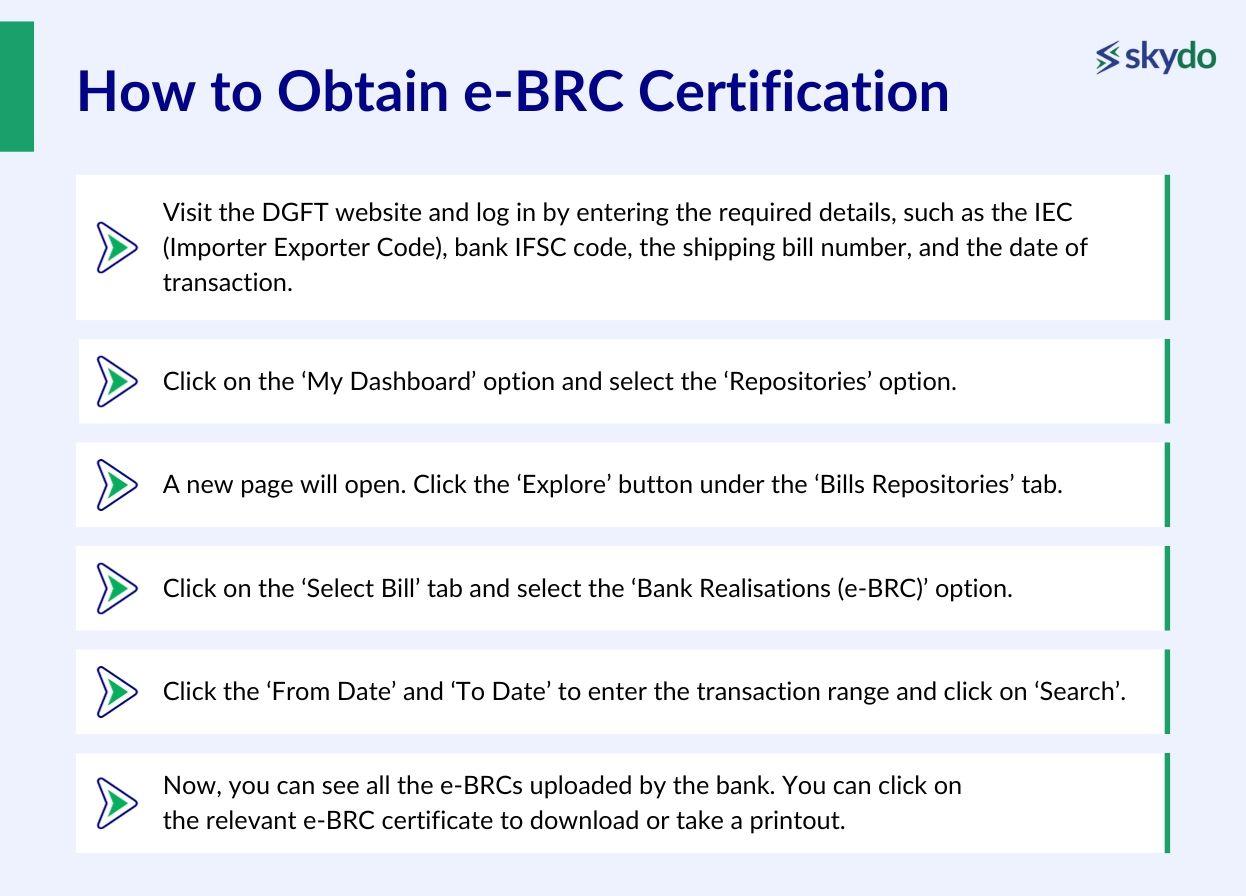
- Visit the DGFT website and log in by entering the required details, such as the IEC (Importer Exporter Code), bank IFSC code, the shipping bill number, and the date of transaction.
- Click on the ‘My Dashboard’ option and select the ‘Repositories’ option.
- A new page will open. Click the ‘Explore’ button under the ‘Bills Repositories’ tab.
- Click on the ‘Select Bill’ tab and select the ‘Bank Realisations (e-BRC)’ option.
- Click the ‘From Date’ and ‘To Date’ to enter the transaction range and click on ‘Search’.
- Now, you can see all the e-BRCs uploaded by the bank. You can click on the relevant e-BRC certificate to download or take a printout.
How to Claim Export Incentives using e-BRC
In India, the DGFT decides on the value of the incentives which an exporter can seek under the various export benefits. The value is decided by analysing the Free on Board (FOB) of the exported goods and services mentioned in the shipping bills, and the total received payments per the e-BRC.
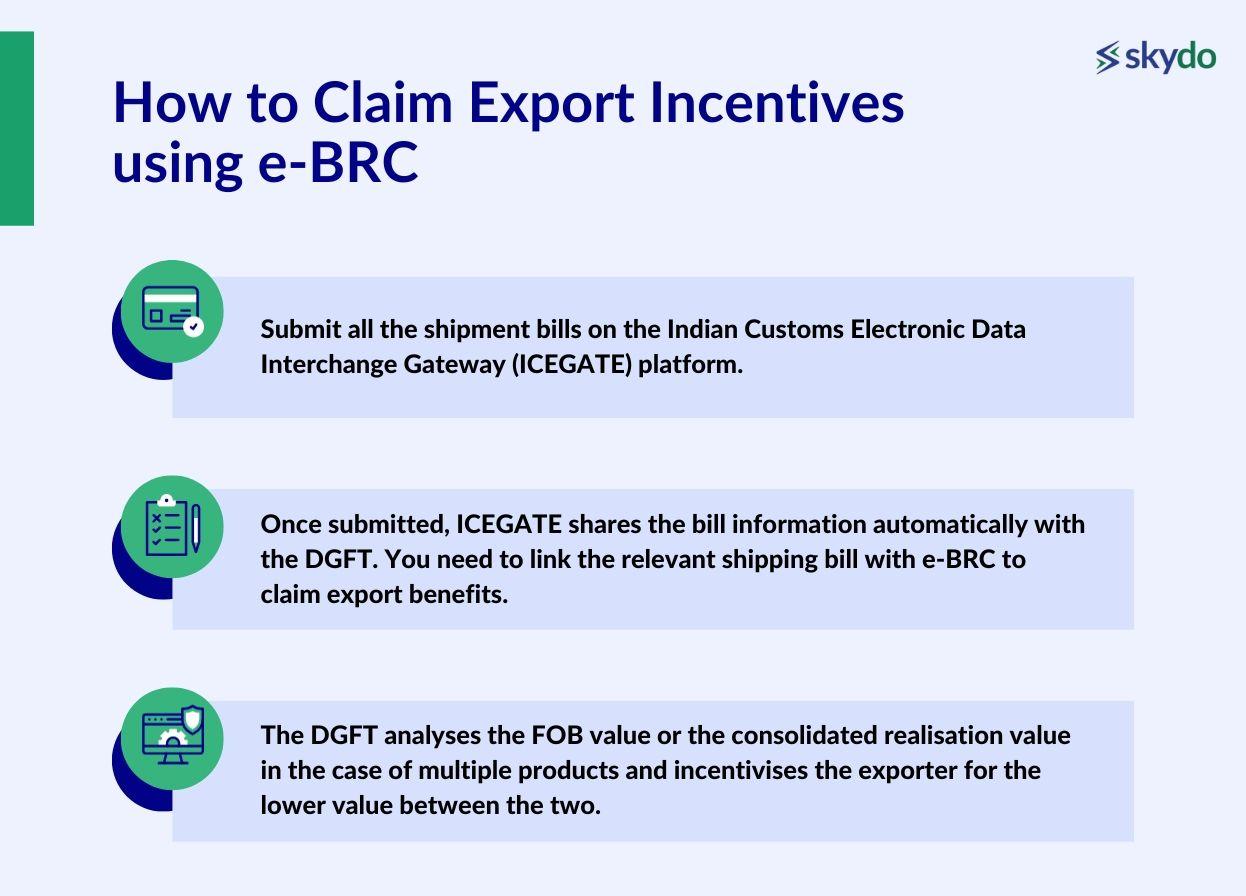
To claim the export incentives–
- Submit all the shipment bills on the Indian Customs Electronic Data Interchange Gateway (ICEGATE) platform.
- Once submitted, ICEGATE shares the bill information automatically with the DGFT. You need to link the relevant shipping bill with e-BRC to claim export benefits.
- The DGFT analyses the FOB value or the consolidated realisation value in the case of multiple products and incentivises the exporter for the lower value between the two.
However, you must ensure that the bank has submitted an error-free e-BRC and it reflects the consolidated realisation value. Furthermore, you must enter freight values, insurance and commission values in the refund application, as the e-BRC excludes such values.

e-BRC Certification Resources and Tools
Here are some key resources and tools that can help you in your endeavour to obtain your e-BRC.
- e-BRC Portal: The e-BRC portal is the primary platform for exporters to apply for and obtain their e-BRC certificates. You can access the portal through the DGFT website. The e-BRC portal provides user manuals and guidelines for exporters.
- Banks: Exporters can also contact their respective banks for guidance on obtaining e-BRC certificates. Banks are involved in the e-BRC issuance process and can explain the documents required and the steps to follow.
- Export Documentation Software: You can streamline your export documentation processes by utilising software solutions available that can assist in e-BRC DGFT submissions. These software tools often integrate with government portals and can assist in generating and submitting the required documents accurately.
Conclusion
E-BRC is a crucial certificate issued by the bank and verified by the DGFT for streamlining the payment procedure for exporters and working as an income proof for better transparency and tax filing.
It is mandatory for an exporter receiving payments for the export of goods and services to apply for e-BRC and ensure that the bank uploads it on the DGFT website. Utilising the e-BRC, exports can present their eligibility for various export incentives and increase their profit margin.
However, as an exporter, you must maintain accurate records of your export transactions and related documents to facilitate the e-BRC application process. Since the regulations and the procedure may change over time, it's important to stay updated with the latest information from official government sources and industry associations.
You can contact industry experts at Skydo to help you with the e-BRC process and in case you have any other queries related to foreign exchange.
FAQs on e-BRC
Q.1: Can I claim a tax refund using the e-BRC?
Ans: You can claim a tax refund using the e-BRC if you are an exporter of services and not any goods. You must attach the e-BRC with the income tax refund application.
You can also apply for income tax credits paid on inputs or IGST (Integrated GST) paid on the exportation of services.
Q.2: What is FIRC, and what is its connection with e-BRC?
Ans: FIRC (Foreign Inward Remittance Certificate) is a certificate issued by a bank for the payments received in return for services export. However, FIRC differs from e-BRC as it also includes the payment received from foreign countries for matters other than exports, such as freight costs, consultancy, etc. When exporters file a GST refund, they may be required to submit FIRC along with e-BRC.
Q.3: What are the documents needed to obtain e-BRC?
Ans: The documents needed to obtain e-BRC DGFT are:
- Business Name and Address proof
- IEC (Importer Exporter Code)
- Shipping Bill for all export transactions
- Bank account details in which the exporter has received the payment
Q.4: Is it possible to obtain an e-BRC for export transactions placed in the past?
Ans: Authorised banks can issue e-BRCs for past export transactions. You need to submit the necessary documentation and follow the relevant regulations. This process helps address any previous documentation problems and ensure compliance with DGFT BRCs for past transactions.
Q.5: Are e-BRCs required for every export transaction?
Ans. Yes, e-BRCs are compulsory for all export transactions per the guidelines established by the Reserve Bank of India. Exporters must obtain and submit e-BRCs to the Directorate General of Foreign Trade (DGFT) to confirm adherence to foreign exchange regulations and verify the repatriation of export earnings.

